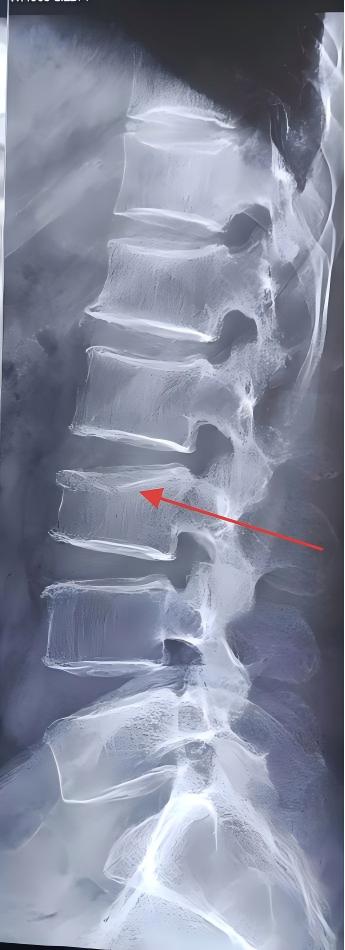
Acute low back pain should be alert to lumbar vertebral compression fractures
Fu's subcutaneous needling (FSN) is not only an effective therapeutic modality but also serves as an excellent diagnostic tool in the hands of experienced practitioners. Recent clinical cases of acute low back pain have fully demonstrated the unique advantages of FSN in diagnostic treatment and differential diagnosis, which I would like to share with fellow colleagues.


Case 1
Patient: Zhang, 75-year-old female, farmer
Chief Complaint: Acute lower back pain for 7 days
The patient suddenly developed a distending pain in the lower back 7 days ago while lifting heavy objects. After bed rest, the pain worsened, and lumbar movement was severely restricted. Getting in and out of bed was particularly difficult. While sitting or standing, placing both hands on the hips slightly alleviated the pain, but the patient was unable to bend or extend the back.
A local township hospital's lumbar CT scan showed "L4/L5 intervertebral disc protrusion and Schmorl's nodes at L2/L3 vertebrae." After one week of intravenous infusion, medication, and acupuncture treatment with unsatisfactory efficacy, the patient was introduced by a friend to undergo Floating Needle therapy. The patient was admitted with a diagnosis of "acute lower back pain." Through consultation, lumbar functional assessment, and palpation of the suspected muscles, the affected muscles were identified as the bilateral quadratus lumborum and oblique abdominis. After each treatment, the patient's pain was temporarily relieved, but it rebounded upon returning home. After three sessions, the patient's lower back pain and restricted mobility were significantly improved in the supine position, but pain persisted when getting up or standing.
As a doctor with ten years of clinical experience in FSN therapy, if acute lumbar sprain remains unresolved after three treatments, it is evident that there is an underlying issue.
After careful consideration, I concluded that the patient's lower back pain might not be solely caused by the affected muscles but also by other factors. The patient, an elderly woman with a hunched posture, experienced acute onset after lifting heavy objects and denied any history of trauma. Given these circumstances, I suspected a vertebral compression fracture and recommended further examination at a higher-level hospital. The following day, the patient was diagnosed with compression fractures of the second and third lumbar vertebrae at a municipal hospital.
Case 2
Patient: Bai, 63-year-old female, cleaner
Chief Complaint: Acute lower back pain for 3 days
The patient suddenly developed lower back pain while forcefully dragging a trash bin down the stairs during cleaning, followed by restricted lumbar movement. Symptoms significantly worsened after rest. Despite taking painkillers and applying topical patches for 3 days with no improvement, she was referred for FSN therapy and was admitted with a diagnosis of "acute lower back pain."
Through consultation, lumbar functional assessment, and palpation, the tightened muscles were identified as the right quadratus lumborum and erector spinae. After three treatment sessions, the patient's lower back pain and functional limitations significantly improved. However, due to difficulties taking leave, the patient returned to work while still unwell. After two additional treatments, the patient reported persistent limitations in bending forward and difficulty getting out of bed, with the therapeutic outcomes not meeting the expected recovery for acute lumbar sprain.
The patient, an elderly female with a history of recurrent lumbar sprains, experienced acute onset of symptoms when forcefully pulling a heavy object, with no history of trauma. The Floating Needle therapy yielded unsatisfactory results. Drawing a parallel with Case 1, the decision was made to have the patient undergo imaging at the hospital. In the afternoon, the patient returned with the lumbar MRI report, which revealed compression fractures of the L1 and L3 vertebrae.
Conclusion
The target tissue of Fu's Subcutaneous Needling (FSN) medicine is singular, acting solely on the loose connective tissue; its target organ is also singular, focusing exclusively on muscle-related pain. This characteristic allows it to serve as a diagnostic tool to determine whether the pain is of muscular origin.
The above two cases both involved acute-onset lower back pain, and while Fu's Subcutaneous Needling (FSN) therapy provided some pain relief, the results fell short of expectations. This indicates that the underlying cause of the lower back pain is not the muscular pain (encompassing pre-muscular, post-muscular, and muscular) .
Elderly women are a high-risk group for osteoporosis, and under external forces such as lifting heavy objects, the lumbar vertebrae and other areas are highly susceptible to compression fractures. It is noteworthy that there are no nerve endings inside the bones, so the fracture itself does not cause pain.
So, how is pain actually caused? In the two cases mentioned, the patients did not achieve the expected results after FSN therapy. The underlying reason is that the surrounding soft tissues were in the acute edema phase following local injury. In fact, aseptic inflammation and edema are the true root causes of pain.
From a physiological and anatomical perspective, soft tissues are richly supplied with nerve endings and blood vessels. Once their surrounding environment changes, local microcirculation becomes impaired, leading to pain due to ischemia and hypoxia. This type of case serves as a warning: when treating certain muscle-related pains such as stiff neck, acute ankle sprain, or acute low back pain, extra caution is required.
Is FSN truly feasible for treating lumbar or thoracic vertebral compression fractures? The answer is yes. For patients undergoing conservative treatment, FSN therapy should be the preferred treatment method. After patients pass through the aseptic inflammation phase and edema phase, their recovery speed will be remarkably fast—thanks to local muscle relaxation and improved microcirculation.
These two cases not only provide crucial clinical warnings for managing acute low back pain (emphasizing the need to rule out acute lumbar compression fractures in elderly patients with acute back pain), but also clarify the direction for using floating needle therapy to post-fracture pain management.
Author's Profile
Yin Changbo
Current Position: Section Chief, Motivational Department, Fu Needle III
Responsibility: Head of Fu Needle Teaching Demonstration Site, Dezhou, Shandong
Role: Assistant Lecturer, Fu Needle Medical Lecture Series
Title: Instructor, Fu Needle Academy
Designation: Science Popularization Ambassador, Fu Needle Academy
Contact: 13583446376 (WeChat same as phone number)




